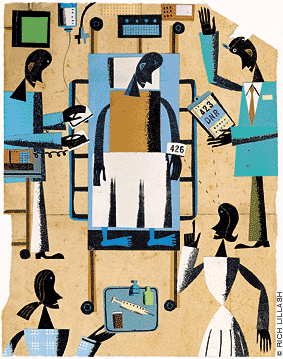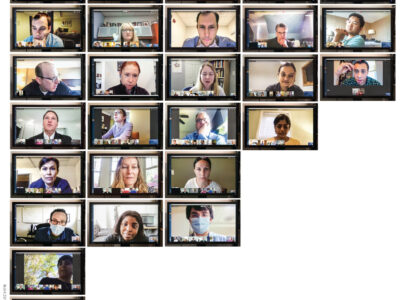
A more collaborative culture in health care could reduce medical errors—and save lives.
By Robert Wachter
“Code Blue, Room 426! Code Blue, Room 426!” The PA blasts in every corner of the hospital. This is an emergency. This is no drill. The Code Team scrambles to the scene. Like cops at a robbery-in-progress, they get the facts while they deploy. A young swing-shift nurse, Jane Hyatt, had just found her patient gray-blue, not breathing, and without a pulse.
Code Blues used to be a medical secret—hence the word code—but the public is well familiar with them now thanks to a generation of TV hospital dramas. Shows like ER and Chicago Hope generally get the details right, especially the first few moments when nobody knows what’s going on and has nothing to fall back on but established procedures. Like a choreographed battle scene, a half-dozen doctors, nurses, and respiratory therapists dash into the patient’s room and prepare their gear. On TV, after a half-minute of great acting, orchestral precision, and some vigorous chest thumping that never musses the hero’s hair, the patient miraculously recovers, smiles gratefully, and thanks the self-effacing doctors—unless, of course, he or she has been written out of the script. The truth, unfortunately, is much more grim. In real life, only one in eight patients who receive CPR for an in-hospital cardiac arrest survives to leave the hospital.
The other thing television gets wrong is the energetic but otherwise unruffled portrayal of the start of most TV codes. The truth is that chaos often reigns supreme, and the Code Blue in Room 426 is no exception. One doctor inserts a large catheter into the patient’s arm so that an IV can be started. Syringes of powerful, life-saving drugs—epinepherine, bicarbonate, amiodarone, atropine—are passed over the patient’s chest like cheese puffs at a spirited dinner party. The team’s doctors and nurses, most of whom have never worked with each other before, shout instructions, yell questions (“Who’s got an 18 catheter?” “Does anybody know this guy?”), and run in and out of the room on special errands. It is semi-organized bedlam.
Aaron Riegel, a physician who just happened to be on the floor when the Code was called, dashes off to the nurse’s station to find the patient’s chart. Riegel is a decisive guy—a senior resident already accepted into an ICU fellowship—and thus no stranger to stress. He thrives on it and radiates confidence, which is good, although some of his colleagues think his confidence borders on cockiness. But whether you like his style or not, you can’t help but notice him. He looks like a TV doctor, with a Hollywood haircut and well-toned physique. And he looks great in a set of scrubs, a pair of clogs, and the fleece vest he habitually wears to tote his doctor paraphernalia. This combination of professional zeal, M*A*S*H-like informality, and yuppie accessorizing shouts not just “good doc,” but “super doc.” His patients adore him.
Riegel returns to Room 426 a moment later, chart in hand. He skids to a stop, flips a couple of pages, then looks at the team in horror.
“Oh my God!” he gasps. “This guy is No Code.” (Medicalese for Do Not Resuscitate.) Everyone stops what they’re doing.
A second or two after the word sinks in, the team begins slowly and deliberately to undo everything they’ve done. Coding a DNR—well, this was a giant screw-up, they all think as they unplug the IV, pack up their paddles, tubes, syringes, and medicines, and file quietly from the room.
A somber Nurse Hyatt begins cleaning up the patient’s room. Just out of nursing school and as yet unaccustomed to the rollercoaster of hospital life, she sometimes feels like a total fraud. But she had been a good student and wants to be a good nurse. She paid attention to things. She knew about DNRs and was surprised nobody mentioned at shift change that the sick old man in 426 had been changed to No Code. She also didn’t remember seeing the order in his chart. But Dr. Riegel had spoken with such authority—who was she to question him?
She glances at the elderly patient, who now looks even more tattered and beaten up. She tucks the sheet and blanket up under his chin, smoothes out the wrinkles, and feels his pulse. A few slow, irregular beats … and then his heart winks out like the embers on a doused campfire. Looking up, she notices Dr. Riegel has left the chart on the foot of the bed. Another floor nurse comes in with a tray to carry off the empty syringes, used tubing, and bloody towels—the detritus of a lost battle—and picks up the chart. Idly, she flips it open.
“Hey, Jane,” she says softly. “Do you know the patient’s original diagnosis? I mean, before the Code?”
Jane picks out the red DNR form—yes, it was there, just as it should be, and she relaxes a bit. Reading upside down, she even sees the patient’s name stamped on the bottom right-hand corner of the page. The only problem is …
“Omigod!” Jane covers her mouth. “That’s not this patient! Dr. Riegel pulled the wrong chart!”
The other nurse looks up, eyes like saucers. “What are you talking about?”
“This patient is full Code, Oh, God! Always has been—I’m sure of it. I’ll go pull his chart. You stay here.”
A few moments later, the PA blares again. “Code Blue, Room 426. Four-twenty-six, Code Blue.”
Heads cock in a hundred places around the hospital—there was no obvious explanation for a re-called code. Dutifully, the Code Team rushes back and picks up where they left off—but this time the patient isn’t responding. They compress and thump and inject and shock, but the tired old heart is finished. The team leader pronounces the patient’s death and pulls the sheet up over his face. For the second time in half-an-hour, the team files dejectedly from the room.
The “story” here, as in so many medical mistakes, seems obvious. It’s easy to blame Dr. Riegel for plucking the wrong chart from the crowded rack and for not checking the name against the patient’s wristband. That a well-meaning provider made a careless blunder is beyond debate. But the death in Room 426 illustrates many other deeply rooted problems: a poorly trained Code Blue team, inadequate procedures for identifying patients during Codes, deficient systems for documenting resuscitation status in charts, and so on. After this case—it always seems to be after, never before—the hospital changed many of these procedures, and added a rule that at least two physicians and a nurse needed to confirm a patient’s identity before a Code could be cancelled.
None of these ideas, though, addressed the root cause of the blunder: Jane Hyatt’s hesitancy to speak up when it mattered. Was the hospital’s culture one that encouraged or inhibited crosstalk and challenges—among colleagues or between levels in the caregiver hierarchy? Answering this question is the only way to understand what really happened in Room 426 on that terrible evening. And to fix it.
Whether it is in the OR or at a Code Blue, medicine has not done a great job in delimiting roles and responsibilities, fostering teamwork, and reflecting on the interpersonal relationships that often define success and failure. Even after a Code Blue, there is virtually never a formal debriefing—the team just breaks up and wanders off, to resume their regular duties. When CPR is unsuccessful, which is most of the time, we may ask ourselves individually why we failed (“Should I have given another dose of epi?”), but our failure as a team is never considered.
Aviation is often held up as a model of how professionals working in high-risk, high-demand, high-tech environments can collaborate successfully without letting hierarchy, tradition, or prejudices get in the way. While pilots are lauded for their receptiveness to collaboration, physicians are seen as poster-boys for inflexibility. The unflattering comparison has some merit. One study compared the attitudes of flight crews regarding teamwork to those held by surgical teams. Nearly half the surgeons felt that junior team members shouldn’t question the decisions of the senior physician. In contrast, 94 percent of airline cockpit crews rejected this sort of hierarchy—possibly because when the captain makes a mistake, he and his entire crew go down as well.
Unfortunately, the doctors who discourage such crosstalk are the kind who need it most. In the survey just described, 70 percent of attending surgeons agreed that, “even when fatigued, I perform effectively during critical times.” Among pilots, only a quarter self assessed as such.
Consider the contribution teamwork—or lack of it—makes in a typical medication mistake. A resident thinks the dose of medication ordered by her attending physician is incorrect, but assumes the highly experienced attending knows what he is doing. The attending hasn’t ordered this medication in a long time, and assumes the young resident is up to speed on the latest meds and knows all the doses.
Besides, wouldn’t a conscientious colleague correct him if he was wrong? The nurse and pharmacist assume that if two doctors were in on the order, there can’t be a mistake, so they process and administer an obviously faulty prescription. The result is a needless medication error that could’ve been prevented if any member of the attending’s “cockpit crew” spoke up when something looked funny.
Judy Hoffer Gittell, a management expert at Brandeis University, argues that while checklist routines and advanced planning may serve other industries well, health care’s triple whammy of limited time, parallel tasking, and decision-making under uncertainty create a unique demand for “relational coordination.”
To test her hypothesis, Gittell studied orthopedic-surgery patients at nine hospitals. She found that patients’ quality of care, pain control, and post-operative functioning were all far better when there was improved relational coordination—better communication, shared problem-solving, common goals, and mutual respect—among caregivers.
Health care is just beginning to appreciate the value of teamwork. In an effort to decrease the chances of wrong-site surgery, many hospitals have recently begun to mandate a “time out” prior to the first incision. This is similar to a team huddle before the snap in football. All the providers—doctors, nurses, operating-room techs—gather around and agree on what the operation is supposed to be.
Some hospitals are beginning programs of aviation-style teamwork training in an effort to improve coordination and tamp down the hierarchy—the culture that kept Jane Hyatt from speaking up when a doctor barked out an order she suspected was fatally wrong. Clearly, we must do much more to create a collaborative culture in health care—one in which all providers at all levels feel free to report and learn from their mistakes, act in concert, and voice their concerns while there is still time to do something about them. Physicians in particular have to see themselves in a new light: not as “Captain of the ship” but as an integral part of a multidisciplinary team in which no role, or voice, can safely be ignored.
Dr. Robert Wachter C’79 M’83 is professor and associate chairman of the Department of Medicine at the University of California, San Francisco, and chief of the medical service at UCSF Medical Center. (He was also the Penn Quaker in 1979, the year of the Penn men’s basketball team’s trip to the Final Four.) This essay is excerpted from Internal Bleeding: The Truth Behind America’s Terrifying Epidemic of Medical Mistakes, coauthored by Wachter and Dr. Kaveh Shojania, courtesy of the publisher, Rugged Land (www.ruggedland.com). The case described above was real; potentially identifying details such as the site and names of patients and providers have been changed.




